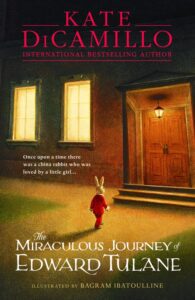Good Hard Knocks
★★★★★

A few years ago, a friend suggested the title The Miraculous Journey of Edward Tulane by Kate DiCamillo as a worthwhile story time read. It is!
In the story, a china rabbit named Edward, who, in spite of being deeply loved, is completely self-absorbed and unable to love others in return. Then suddenly he is thrust into a cruel world where he encounters a series of extremely painful hardships. Bit by bit, these dire circumstances begin to soften his hard heart and invite him to experience inner life. In the end he has been broken (quite literally), and yet, it is these very things that teach him to hope, to feel gratitude, and to love others. While this well told story is chock full of lessons about life, it includes no direct moralizing.

The story line confirms what my heart is slowly learning to believe – while it is true we spend our lives diligently seeking to avoid pain, in reality, difficulties of all shapes and sizes are actually an essential aspect of life. Without them, we simply cannot live well. Indeed, is it possible to learn empathy and compassion without having experienced pain ourselves? Is it possible to learn to forgive without being mistreated? Is it possible to learn endurance or diligence without the having to actively choose to stick to the task at hand in the midst of distractions and other inconveniences? Ironically, a life worth living requires hardship.
After completing the book, my students and I used the next story time slot to discuss the story line. Using a visual graphic on the board, I recorded the students’ eager descriptions of Edward at the beginning of his life and then in a different circle, words that described him at the end. From there I drew a wide arch (a bit like a rainbow) connecting the two “clouds” and invited them to discuss what influenced the dramatic changes. What powerful elements had so softened and molded him? Although it is always easier to think of pain as a positive tool when speaking in the third person, I found again that even third and fourth graders are well able to begin applying these ideas to their own lives. Other’s stories invite us to consider our own stories. Could Edward’s story become their own?
That same day at recess time, one of the students dissolved into tears. He felt disrespected because a classmate threw a really hard snowball at him after he had asked him to stop. This offered me the chance to again walk both him and the offender through the essential practice of offering and receiving an apology. But then, after a bit of care and space, I was given words to carry the incident to a different level. In a gentle, yet forthright manner, I suggested to the offended child that even this pain could turn out for good. Doesn’t he have younger siblings he is too rough with sometimes? (The answer is yes.) Now he will understand better how it feels, and will be more equipped to show heartfelt compassion to others. I believe he understood, and received my hard words. They were offered with love and warm eye contact, and I know he trusts me.
As I myself grow in believing pain is never meant to be wasted, and, however falteringly, live this truth out in my own life, I stand on a platform from which to naturally speak of these concepts when those inevitable opportunities arise.
As teachers we ought to, and we do, intentionally teach and require habits of respect in the classroom. But there is another side of the coin – hard knocks will come and they are not a dead end. Maybe they could be viewed as a junction in the road. I observe that when we see all pain as negative, it pushes us to anxiously micromanage situations and people in an ardent desire to protect the hearts of the flock under our care. Could it be that in so doing we actually end up short circuiting the miraculous work pain longs to do in our hearts when we, like Edward Tulane, are broken by its sharpness?
I think the answer is yes.
I walked a mile with Pleasure; she chatted all the way;
But left me none the wiser for all she had to say.
I walked a mile with Sorrow, and ne’er a word said she;
But, oh! The things I learned from her, when sorrow walked with me.
—Robert Browning Hamilton
Related Items
Leave a Reply
Feedback